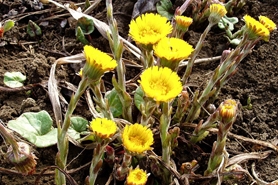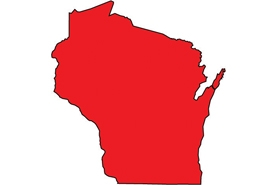Colt's foot
(Tussilago farfara)
Herbaceous perennial superficially resembling small common dandelion. It spreads mainly by underground rhizomes.
Other names for this plant include:
- Common names: Horsehoof, coughwort, bull's foot, foalswort
Classification in Wisconsin: Prohibited
- Ecological Threat
-
- They are recognized as invasive and banned in numerous states throughout the country.
- Invades forests, riparian areas, wetlands, grasslands, lake edges, marshes, fens, sand dunes, upland, and disturbed areas.
- Tolerant of many soil types and conditions but requires some consistent soil moisture.
- Forms large stands and reduces the number of native species in the herb layer.
- A single plant can produce thousands of seeds with high germination rates.
- Identification
-
Leaves & stems: Leaves emerge as a small basal rosette after flowering. Stems have alternate leaves with one leaf per node. Deciduous leaves are heart-shaped with long petioles (stalk that attaches the leaf to the stem). The upper sides of the leaves are dark green and smooth, almost waxy. The undersides of the leaves are covered in fuzzy white-felt. Flowering stems are covered in wooly hairs. Numerous flowering stems arise from one root crown. During flowering, stems are 2-6 inches tall and can reach up to 20 inches at flower maturity.
Flowers: Radial flowers have numerous yellow, fertile ray florets around the periphery and sterile disc florets in the center. Single flowers occur at the end of the flowering stems. Flower heads range from 1-1.25 inches wide.
Fruits & seeds: Resemble the common dandelion. Seeds are achenes (single seeds) attached to pappus (feather-like structure). One plant can produce 100 to 1,000 seeds per flowering head.
Roots: Plants have a primary taproot with deep, extensive rhizomes.
Similar species: This plant resembles the common dandelion (Taraxacum officinale; non-native) but can be distinguished by the wooly white undersides of leaves and by small purple bracts on flowering stems.
- Control
-
Increased vegetation density and overstory cover have decreased colt's foot abundance; therefore, reintroducing native vegetation following any control procedure is highly recommended.
Mechanical:- Manual removal of plants can be challenging for large populations; initial infestations may be controlled by hand pulling. Residual roots left in the soil may resprout.
- All of the underground portions of the plant must be removed.
- Pulling when the ground is moist may make it easier to remove the entire plant.
- Pull before the plant has set-seed to reduce further spread.
- This species resists many more commonly used and selective herbicides (e.g., 2,4-D, dicamba, MCPA, 2-4DB).
- One study in England found a mixture of 2-(2,4,5-trichloro phenoxy) propionic acid (silvex) and MCPA (2-methyl-4-chloropheonoxyacetic acid) gave 90% control in a wheat crop.
- A 2% solution of glyphosate or triclopyr and water plus a non-ionic surfactant using a tank or backpack sprayer to cover all leaves thoroughly.
- Treatments should be done in the summer when coltsfoot leaves are fully developed.
- Resources
- Sources for content:
- Innes, Robin J. 2011. Tussilago farfara. In: Fire Effects Information System, [Online]. US Department of Agriculture, Forest Service, Rocky Mountain Research Station, Fire Sciences Laboratory (Producer). Available: https://www.fs.fed.us/database/feis/plants/forb/tusfar/all.html [2020, Feb. 19].
- Global Invasive Species Database; www.iucngisd.org/gisd/
- Center for Invasive Species and Ecosystem Health; invasive.org
- US Department of Agriculture, Forest Service
- Invasive Plant Atlas of New England [exit DNR]
- Global Invasive Species Database [exit DNR]
- US Department of Agriculture, Forest Service [exit DNR]
- Center for Invasive Species and Ecosystem Health [exit DNR]
- Wisconsin State Herbarium [exit DNR]
- Ohio State University Extension, Ohio Perennial and Biennial Weed Guide [exit DNR]



